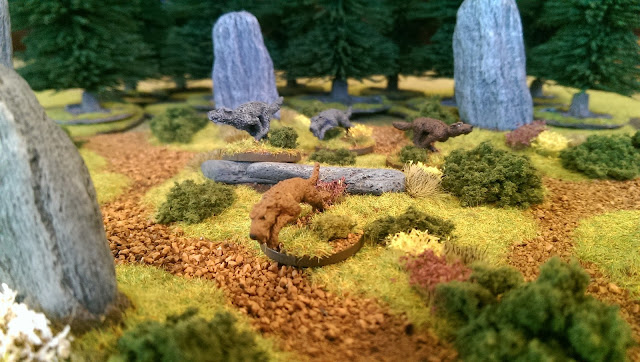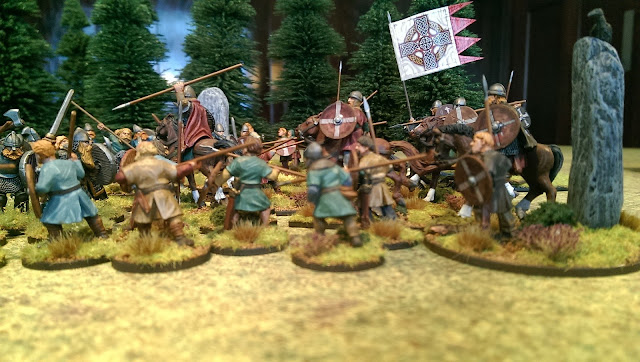Cela fait 3 mois que je n'ai rien publié sur mon blog, ce qui ne signifie nullement que je n'ai rien peint. J'ai eu de nombreux projets et la flemme de prendre des photos.
Après une longue absence, voici quelques photos de ma nouvelle armée pour la version 2 de Saga.
(English version follows)
Après avoir passé ces dernières années à jouer diverses factions, je reviens enV2 à ma toute première armée avec laquelle j'ai commencé en
V1 : les Bretons.
J'ai choisi comme thème une bande bretonne réunie autour d'Alain Barbetorte (le Renard) pour bouter les hommes du Nord hors de Bretagne !
Al louarn barveg a glip, glip, glip, glip, glip er c'hoad;
Goa konikled arall-vro !
Lemm-dremm he zaoulagad !
Lemm e zent ha skañv e dreid hag e graban ruz-gwad !
Alan-al-Louarn a glip, glip, glip : argad ! argad !
Adalek ti sant Weltas tre-betek Penn-ar-Bed;
E pevar c'horn eus a Vreizh be'et al Louarn meulet !
Le Renard barbu glapit, glapit, glapit au bois;
malheur aux lapins étrangers !
Ses yeux sont deux lames tranchantes !
Tranchantes sont ses dents, et rapides ses pieds, et ses ongles rougis de sang;
Alain-le-Renard glapit, glapit, glapit, glapit : guerre ! guerre !
Depuis l'abbaye de Saint-Gildas, jusqu'au cap où finit la terre;
qu'aux quatre coins de la Bretagne le Renard soit glorifié !
Alain II de Bretagne, dit « Barbetorte » ou « al Louarn » (en breton : « le renard »), (né vers 903 - mort en 952 à Nantes) est le fils de Mathuedoï de Poher et petit-fils par sa mère d’Alain le Grand, dernier roi de Bretagne.
Son père et lui s’exilent en Angleterre dans les années 920 auprès du futur roi Æthelstan (parrain d'Alain selon la chronique de Nantes).
Alan II, nicknamed Wrybeard or Twistedbeard (French: Barbe-Torte) and Alain al Louarn (Breton: "the Fox"), Duke of Brittany from 938 to his death, was the grandson of King Alan the Great by Alan's daughter and her husband Mathuedoi, Count of Poher. He expelled the Vikings from Brittany after an occupation that lasted from 907 to about 939.
He had to take refuge, along with his father Mathuedoi I, Count of Poher, with the English king, Æthelstan, because the Norsemen had invaded Brittany. The Chronicle of Nantes reports:
"... Among the nobles who fled for fear for the Danes, Mathuedoi, the count of Poher, put to sea with a great multitude of Bretons, and went to Athelstan, king of the English, taking with him his son, called Alan, who was afterwards surnamed "Crooked Beard". He had had this Alan by the daughter of Alan the Great, duke of the Bretons, and the same Athelstan, king of England, had lifted him from the holy font. This king had great trust in him because of this friendship and the alliance of this baptism."
Les Vikings au Xe siècle ne se contentent plus d'expéditions de pillages comme au siècle précédent, ni même de se retirer contre paiement d'un tribut de type « Danegeld » mais ils cherchent à se substituer aux seigneurs locaux et à établir une principauté comme ils l'ont fait à la même époque en Irlande à Dublin et Limerick, en Angleterre à York et dans le Danelaw, et même en 911 à Rouen. Par ailleurs, les Francs tentent de contrôler le pays Nantais.

D'après le récit épique fait par Arthur de la Borderie, Jean, abbé de Landévennec, exilé comme les principaux membres de l'aristocratie bretonne depuis 919, revient en Bretagne vers 935, et recrute des hommes qui, réfugiés dans les rochers inaccessibles de la côte de Crozon, résistaient aux Vikings sous la direction de deux chefs locaux Amalgod et Wethenoc. Il envoie ensuite des hommes sûrs à la cour d'Æthelstan pour informer de la situation Alain, fils de Mathuedoï, et le presser de prendre la direction des Bretons. Jean regroupe des partisans afin de lui fournir une petite armée, et lui fait prêter serment par Amalgod et Wethenoc. À l’initiative de l’abbé Jean de Landévennec, avec l’aide d’une troupe de Bretons exilés et d’Anglais, Alain débarque en 936 en Bretagne près de Dol-de-Bretagne, et attaque ensuite le camp de Péran. Il combat les Normands à Plourivo avant de marcher sur la Loire et Nantes et de les en chasser en 937. Il est reconnu « Brittonum dux » en 938.
Alan became ruler of Brittany at the end of a 33-year interregnum after the death of his maternal grandfather, Duke Alan the Great. He landed at Dol in 936, at the invitation of the monk Jean de Landévennec and with the aid of Edward's successor, Athelstan the Glorious. By 937 he was master of most of Brittany, having forced the Vikings back to the Loire.
"... The city of Nantes remained for many years deserted, devastated and overgrown with briars and thorns, until Alan Crooked Beard, grandson of Alan the Great, arose and cast out those Normans from the whole region of Brittany and from the river Loire, which was a great support for them. This Alan was brought up from infancy with Athelstan, king of the English, and was strong in body and very courageous, and did not care to kill wild boars and bears in the forest with an iron weapon, but with a wooden staff. He collected a few ships and came by the king's permission with those Bretons who were still living there, to revisit Brittany."
Alan was made Brittonum Dux, King of Brittany after his victory in Nantes. At his death in 952, Brittany was free of the Vikings/Normans.
Pendant que je m'attaquais à la peinture de cette armée, j'en ai profité pour faire quelques décors typiques de la Bretagne entre deux unités/
- Bran, en breton signifie le corbeau, il est le messager, symbole des bonnes nouvelles
- Un cercle de pierres et menhirs
- Alan, seigneur des Bretons armoricains
- Dogues de Brocéliande (guerriers)
- Gardes et porteur de la grande bannière
Bataille du camp de Péran en 936 entre Vikings et Bretons










































































